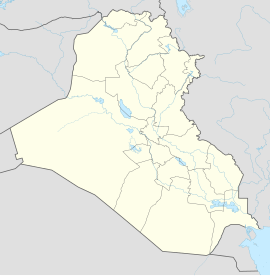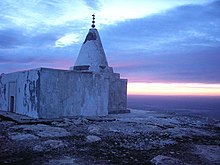Sinjar
| Sinjar | ||
|---|---|---|
| location | ||
|
|
||
| Coordinates | 36 ° 19 ′ N , 41 ° 52 ′ E | |
| Country |
|
|
| Governorate | Ninawa | |
| Basic data | ||
| height | 520 m | |
| Residents | 84,338 (2014) | |
| mayor | Fahad Hamid Omar | |
Sinjar (other spellings: Sinjar, Singar or Shingal, Kurmanji - Kurdish شنگال Şingal , Aramaic ܫܝܓܳܪ Shiggor , Arabic سنجار, DMG Sinǧār ) is an Iraqi city in the province of Ninawa with 39,875 inhabitants (as of 2006). At the same time, Sinjar is also the capital of a district of the same name . The city is located south of the Jabal Sinjar and is one of the disputed areas of northern Iraq .
The residents of Sinjar mainly speak Shengali, which is a dialect of the northwest Iranian language Kurmanji , and belong to the ethno-religious minority of the Yazidis . The city is administered by the Iraqi central government. The status of the city is not clear. According to article 140 of the Iraqi constitution , a referendum should decide whether it should continue to be administered by the central government or the Kurdistan Autonomous Region .
history
Antiquity
In ancient times the place was called Singara . Located at the foot of Mount Sinjar, it was of great strategic importance. In Roman times Singara was heavily fortified and a legionary location (for example for the Legio I Parthica ). In late antiquity , the city was repeatedly the target of attacks by the Sassanids . In 344 a great battle took place here, in which the Roman Emperor Constantius II had almost won when the undisciplined behavior of his troops cost him victory. In the peace of 363 the city was awarded to the Sassanid king Shapur II . There are still some remains from Roman times. The place can also be equated with the shinar of the Bible ; at least the name is derived from it.
There must also have been a larger Christian community in Singara, from which, among others, Gabriel von Schiggar came, who was the personal doctor of King Chosraus II in the 7th century .
Fights 2014-2015
In August 2014 fled thousands of people living in Sinjar Yezidis from the Sunni IS -Kämpfern especially in the ridge of the Sinjar Mountains, some of them in Turkey or in the Autonomous Region of Kurdistan . Previously, the Kurdish Peshmerga stationed in Sinjar fled and left the civilian population defenseless. The Yazidis received military support from the Kurdish fighters YPG . US combat bombers attacked IS military equipment (trucks, artillery, tanks). US and Kurdish transport planes supplied the refugees with food in the Sinjar Mountains. YPG fighters, together with fighters from the HPG , managed to clear a corridor to Syria and hold it, which enabled those trapped to escape from the mountains.
In mid-October 2014, the IS militia started another offensive and were able to draw the basin down to the foot of the mountains; about 7,000 civilians were trapped in the mountains. Only the place Sharaf ad-Din could be held in the battle for Sharaf ad-Din by the Yezidi vigilante groups Hêza Parastina Şingal (HPS) and Yekîneyên Berxwedana Şingal (YBS), which had been formed in the meantime . The remaining villages had to be given up in retreat battles.
On November 1, 2014, it became known that the Peshmerga had launched an offensive to liberate the city. In December 2014, parts of the city were already in Kurdish hands. Mass graves were found in Hardan , a Yezidi village near Sinjar.
In 2015 Sinjar was still fought over. On the Kurdish side, several different militias are involved, which are at odds with one another. Masud Barzani announced on August 3, 2015 that the Sinjar region should become part of the autonomous Kurdish region. After a new major offensive ( Operation Free Shingal ) in autumn 2015, circles of the Kurdish autonomous government announced on November 13, 2015 that Peshmerga had penetrated Sinjar from all sides and that central buildings had been occupied. In the course of the day the city was liberated from the hands of the IS; the IS militias did not resist, but fled. In addition to the Peshmerga, which in turn consisted largely of Yazidi fighters, members of the YBS, HPS, YPG and PKK were also involved in the action . The loss of Sinjar was a major setback for ISIS, as the two most important IS locations, ar-Raqqa (Syria) and Mosul (Iraq), are connected by the highway along the Jabal Sinjar.
After the reconquest, a mass grave was found with the bodies of 78 Yazidi women. The mayor of Sinjar said that there was no trace of around 10,000 residents; it is believed that most of them were murdered.
Individual evidence
- ^ Deutsche Welle (www.dw.com): Iraq: The lost home of the Yazidis | DW | 08/02/2018. Retrieved on February 15, 2019 (German).
- ^ Loveday Morris: Islamic State seizes town of Sinjar, pushing out Kurds and sending Yazidis fleeing. Washington Post, August 3, 2014, accessed October 23, 2014 .
- ^ Fears for relatives: Yazidis in Germany take to the streets. Handelsblatt.de, August 8, 2014, accessed on October 23, 2014 .
- ^ Deutsche Welle (www.dw.com): Yazidis: "They have let us down" | DW | 08/08/2015. Retrieved on February 25, 2019 (German).
- ^ Günter Seufert: The upswing of Kurdish politics. Science and Politics Foundation, May 2015, p. 41 , accessed on September 3, 2018 .
- ↑ dpa: Kurds fought back another IS attack on Kobane. Der Standard , November 1, 2014, accessed November 1, 2014 .
- ↑ Terrorist group: ISIS militia is said to have executed more than a hundred "deserters". spiegel.de, December 20, 2014
- ↑ Grisly finds in Iraqi Yazidi village wrested from militants. Newsobserver, December 24, 2014, accessed February 1, 2015.
- ↑ - ( Memento of the original from July 24, 2016 in the Internet Archive ) Info: The archive link was inserted automatically and has not yet been checked. Please check the original and archive link according to the instructions and then remove this notice.
- ↑ Kurds recapture Sinjar from IS. Time online, November 13, 2015.
- ↑ a b c Carsten Stormer: Free at last! Sinjar, the city of the Yazidis, lies in ruins - but it is no longer in the hands of the “Islamic State”. In: Die Zeit, December 10, 2015, pp. 68–69.
- ↑ Hasnain Kazim: The ghost town. spiegel.de, December 29, 2015.



